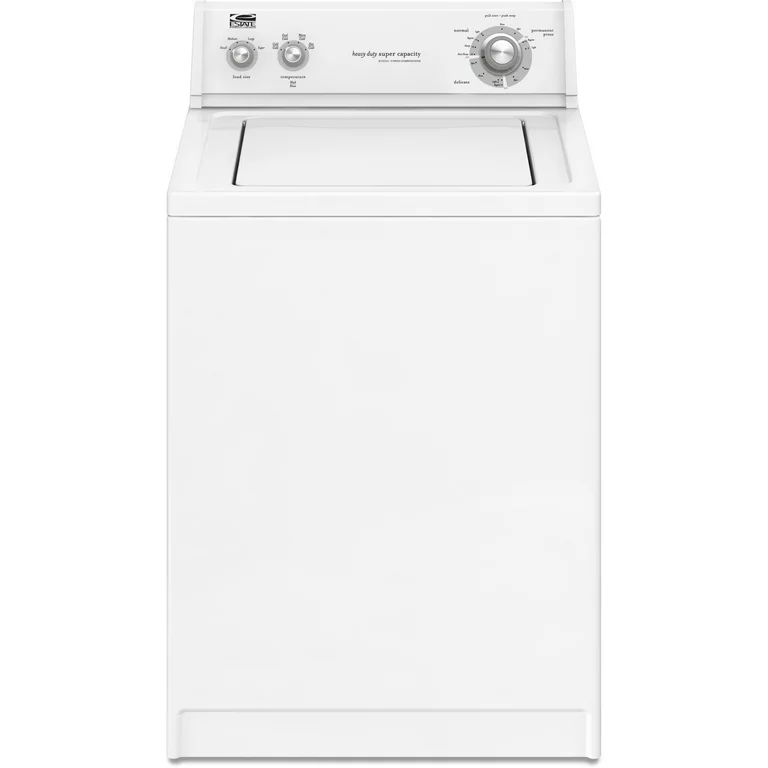Dealing with a malfunctioning dryer is quite frustrating, especially if it fails to provide the essential heat needed to dry your clothes. A well-functioning Estate dryer should ensure that your laundry is dry and warm. However, if your Estate dryer not heating properly then you will be left with damp and cold clothes, adding to your laundry woes.
However, there is nothing to worry as in this article we will explore some of the typical reasons behind a malfunctioning Estate dryer and help you with a detailed step-by-step guide to resolve the problem.
By following these troubleshooting techniques, you might be able to avoid the inconvenience and expense associated with hiring a repair service.
Understanding the Parts of an Estate Dryer

Understanding the parts of an Estate dryer is crucial for effective troubleshooting and diagnosing of any heating problems. By familiarizing yourself with these components, you can quickly identify the issue and resolve it efficiently.
- The heating element: is the primary component responsible for generating heat in the estate dryer. It consists of a long coil that heats up when an electrical current passes through it. The heat generated by the heating element is what dries the clothes. If the heating element is faulty or damaged, it will not provide the necessary heat, resulting in ineffective or non-existent drying.
- The thermal fuse: is an important safety feature in the dryer. It is a small, heat-sensitive device that is designed to blow if the temperature inside the dryer exceeds a certain limit. The thermal fuse acts as a protective measure to prevent the dryer from overheating and potentially causing a fire. If the thermal fuse blows, it will disrupt the electrical circuit and stop the dryer from functioning. This indicates a potential heating problem that needs to be addressed.
- The high-limit thermostat: also plays a crucial role in regulating the temperature inside the dryer. It works in tandem with the thermal fuse to monitor and control the dryer’s temperature. If the temperature rises too high, the high-limit thermostat will cut off the power to the heating element, preventing further heating. This safety feature ensures that the dryer does not reach excessively high temperatures, which can damage the clothes or pose a fire hazard.
- The cycling thermostat: is another thermostat in the estate dryer that is responsible for controlling the temperature during the drying cycle. Unlike the high-limit thermostat, the cycling thermostat continuously monitors the temperature inside the dryer and cycles the heating element on and off as needed to maintain a consistent temperature. This ensures efficient drying while preventing overheating. If the cycling thermostat malfunctions or fails, it can lead to temperature inconsistencies and improper drying.
Fixed: Estate Dryer Not Heating
Now that you understand the crucial components of an Estate dryer responsible for heating, let’s move on to troubleshooting the problem.
Follow these steps to determine the cause and fix Estate dryer not heating issue:
Check the Power Supply
The first step in troubleshooting your Estate dryer is to ensure that it is receiving adequate power. Start by checking the circuit breaker or fuse box to see if the dryer’s circuit has tripped or the fuse has blown.
Look for any fuses that may be blackened or have a broken filament inside. If you find any blown fuses, replace them with new ones of the same amperage rating, or reset the circuit breaker if necessary.
It is also important to ensure that the dryer’s power cord is securely plugged into a functioning outlet. Sometimes the cord can become loose or unplugged without realising it, leading to a lack of power.
Make sure to check the outlet itself as well, as it may not be supplying power to the dryer.Another possible cause of inadequate power is a damaged or frayed power cord.
Examine the cord for any visible signs of damage and replace it if necessary. It is important to always use a suitable replacement that matches the specifications of your dryer
A lack of adequate power can prevent the dryer from heating up properly. By checking the circuit breaker or fuse box, ensuring the power cord is securely plugged in, and addressing any damaged cords, you can ensure that your Estate dryer is receiving the necessary power to function correctly.
Verify the Dryer Settings
Sometimes, the issue with a dryer not working properly may not be with the machine itself but with the settings that you have selected. It’s important to make sure that the dryer is set to the appropriate heat cycle and temperature for the type of clothing or fabric you are drying. Different fabrics require different heat settings to avoid damage or shrinkage.
If your dryer has multiple heat settings, try selecting a higher heat option to see if it resolves the problem. Sometimes, using a lower heat setting may cause clothes to remain damp or take longer to dry. However, be cautious not to select a heat setting that is too high for delicate fabrics, as this can also lead to damage.
Additionally, it’s essential to check if the dryer is accidentally set to the “Air Fluff” or “No Heat” setting. These settings are designed to provide only air circulation without any heat. If your clothes are not drying, check if this setting is active and change it accordingly.
Remember that proper maintenance and regular cleaning of the dryer’s lint trap and vent are also crucial for efficient drying. Excessive lint buildup can restrict airflow, affecting the drying process. By ensuring you have the correct settings selected and maintaining your dryer properly, you can troubleshoot and potentially resolve issues with drying your clothes effectively.
Inspect the Ventilation System
If your Estate dryer not heating then it could be an issue with the ventilation system. A clogged or restricted ventilation system can cause significant problems for your dryer, including overheating and a reduction in heat output.
The first step in troubleshooting this issue is to check your dryer’s lint filter. Over time, the lint filter can become clogged with built-up lint and debris, which restricts airflow. By removing any lint or debris from the filter, you can improve airflow and prevent overheating.
Next, it’s important to inspect the venting hose or ductwork connected to your dryer. These components can become blocked or kinked, further hindering airflow.
Check for any obstructions or damage, and clean or straighten the hose or ductwork as necessary. In some cases, it may be necessary to replace the venting system if it is in poor condition.
Having a proper airflow is crucial for the efficient operation of your dryer. Without adequate airflow, the heat produced by the dryer cannot escape, which leads to overheating and a decrease in heat output.
Regularly checking and cleaning your dryer’s lint filter, as well as inspecting the venting system, will help ensure that airflow is not restricted and your dryer can operate safely and effectively.
Check the Heating Element
If the previous steps haven’t resolved the issue, it’s time to inspect the heating element. The heating element is responsible for producing the heat necessary for drying your clothes. Start by unplugging the dryer and accessing the heating element. Refer to your Estate dryer’s manual for specific instructions on how to access the heating element.
Once you have located the heating element, visually inspect it for any visible signs of damage or breakage. If you notice any abnormalities in the element, it may need to be replaced.
To test the heating element, use a multimeter to check for continuity. Set the multimeter to the continuity setting and touch one probe to each end of the heating element. If Estate dryer not heating up, you will need to replace the heating element.
Test the Thermal Fuse and Thermostats
Next, test the thermal fuse and thermostats to ensure they are functioning correctly. Start by unplugging the dryer and locating the thermal fuse and thermostats.
The thermal fuse is a safety device designed to prevent overheating. It is usually located on the blower housing or near the heating element. The thermostats, on the other hand, control the temperature in your dryer.
Use a multimeter to check for continuity in these components. Set the multimeter to the continuity setting and touch one probe to each end of the thermal fuse and each thermostat.
If Estate dryer not heating, replace the faulty component. It’s important to note that some dryers may have multiple thermostats, so make sure to check each one.
Evaluate the Cycling Thermostat
The cycling thermostat plays a crucial role in maintaining the temperature within your dryer. It is responsible for regulating the heat by turning the heating element on and off as needed. However, if this component is malfunctioning or not working correctly, it can result in the heating element not turning on at all, which can hinder the dryer’s effectiveness in drying your clothes.
To troubleshoot and fix this issue, you can start by ensuring that the dryer is unplugged before proceeding with any maintenance tasks. Then, you need to locate the cycling thermostat within the dryer. It is typically located near the heating element or at the rear of the drum.
Once you have found the cycling thermostat, you can employ a multimeter to test it for continuity. Set the multimeter to its continuity setting and touch one probe to each end of the thermostat. If there is no continuity, this indicates that there is an electrical break within the component, and it needs to be replaced.
Replacing the cycling thermostat is relatively straightforward and can usually be done by carefully removing the old thermostat and attaching the new one in its place, following the instructions provided with the replacement part. It is essential to ensure that you choose the appropriate thermostat suitable for your dryer model.
By fixing the cycling thermostat, you can restore the proper functioning of your dryer, allowing it to heat up properly and dry your clothes efficiently. If you are unsure about performing the troubleshooting or replacement yourself, it is always advisable to consult a professional technician to ensure a safe and successful repair.
Evaluate the Cycling Thermostat
The cycling thermostat plays a crucial role in maintaining the temperature within your dryer. It is responsible for regulating the heat by turning the heating element on and off as needed. However, if this component is malfunctioning or not working correctly, it can result in the heating element not turning on at all, which can hinder the dryer’s effectiveness in drying your clothes.
To troubleshoot and fix this issue, you can start by ensuring that the dryer is unplugged before proceeding with any maintenance tasks. Then, you need to locate the cycling thermostat within the dryer. It is typically located near the heating element or at the rear of the drum.
Once you have found the cycling thermostat, you can employ a multimeter to test it for continuity. Set the multimeter to its continuity setting and touch one probe to each end of the thermostat. If there is no continuity, this indicates that there is an electrical break within the component, and it needs to be replaced.
Replacing the cycling thermostat is relatively straightforward and can usually be done by carefully removing the old thermostat and attaching the new one in its place, following the instructions provided with the replacement part. It is essential to ensure that you choose the appropriate thermostat suitable for your dryer model.
By fixing the cycling thermostat, you can restore the proper functioning of your dryer, allowing it to heat up properly and dry your clothes efficiently. If you are unsure about performing the troubleshooting or replacement yourself, it is always advisable to consult a professional technician to ensure a safe and successful repair.
Conclusion
So those were some of the fixes for Estate dryer not heating issue. A malfunctioning Estate dryer that fails to heat up can be frustrating, but by following these troubleshooting steps, you can fix the issue yourself in most cases. Remember to always ensure the dryer is properly disconnected before performing any repairs or tests.
If you are uncomfortable or unsure about any aspect of the repair process, it is recommended to seek professional help. A certified technician will have the knowledge and expertise to diagnose and fix the issue with your Estate dryer efficiently and safely.
By taking the time to troubleshoot and repair your Estate dryer, you can save both time and money while extending the lifespan of your appliance. Regular maintenance, such as cleaning the lint filter and venting system, can also help prevent future issues with your dryer’s heating system.
If the troubleshooting steps outlined in this guide do not resolve the issue, it may indicate a more significant problem with the dryer. In such cases, it is best to contact a professional technician for further assistance and diagnosis.
Also Check:




![Maytag Gas Dryer Stuck on Sensing [Fixed]](https://troubleshootingpoint.com/wp-content/uploads/2024/01/Maytag-Gas-Dryer-Stuck-on-Sensing-768x432.jpg)

